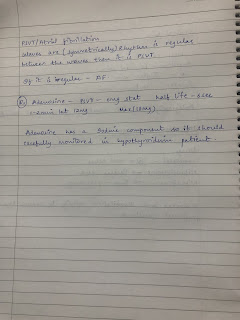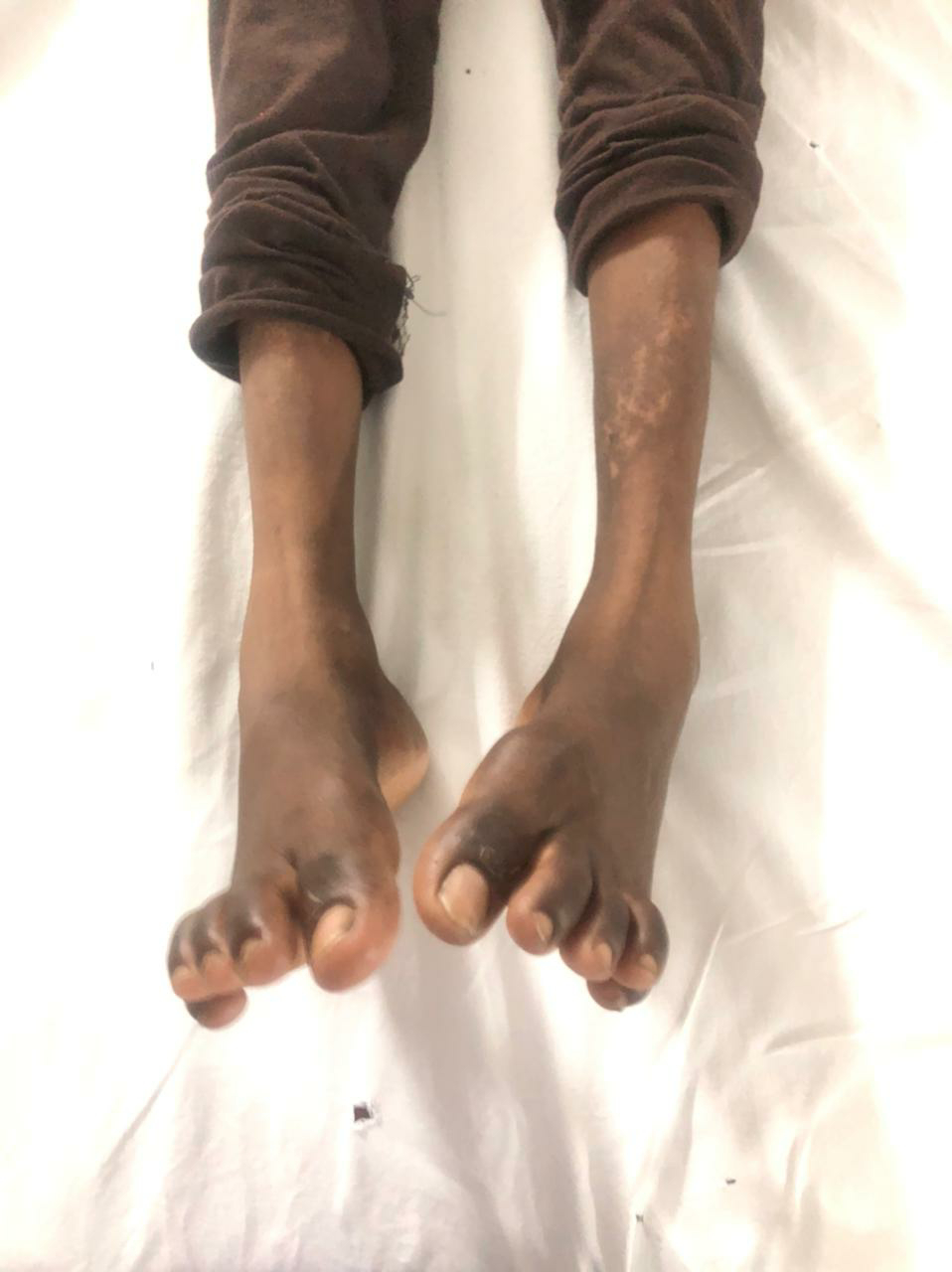18 year old male with difficultly in squatting and edema
You can find the entire real patient clinical problem in this link here made by our interns
https://hitesh116.blogspot.com/2020/05/12may-2020-elog-medicine-intern.html?m=1
https://srianugna.blogspot.com/2020/05/hello-everyone.html
Following is my analysis of this patient's problem:
CHIEF COMPLAINTS:
The problems in order of priority I found are ÷
Weakness of both lower limbs since 20 days
Bilateral edema in lower limbs.
1- ANATOMICAL LOCATION OF THE PROBLEM
From the above CNS examination it is observed that there might be lesion in LMN pathway.
LMN LESION can be particularly divided into
1)neurogenic(anterior horn cell and peripheral nerves)
2) neuromuscular junction
3) muscle
If suspecting neurogenic cause:
Here nerve conduction test is done which is normal so we can rule out neurogenic cause
If suspecting Neuromuscular junction cause
Electromyography is done which is normal and thus neuromuscular junction disorders like myesthenia gravis and lamborten Eaton syndrome are ruled out .
Finally we left with muscular cause.
Muscle biopsy should be done and examination of creatine kinase levels must be done.
Creatine levels -increased
Muscle biopsy report(quadriceps femoris)- suggesting no evidence of POLYMYOSIS and may be suggestive of dystrophy.
Other investigations
1.CBP -normocytic normochromic with leucocytosis
2.serology
3.RFT-creatinine and uric acid levels are slightly elevated
4.ECG- normal
5.CUE- pus cells seen
are done and these reports are within normal range.
2-ETIOPATHOGENESIS OF ABNORMALITY PRESENT IN MUSCLE (MYOPATHIES)
We have to rule out each and every myopathies as follows
1}INFLAMMATORY MYOPATHIES 2} METABOLIC MYOPATHIES
3)DRUG INDUCED MYOPATHIES
4)ENDOCRINE MYOPATHIES
5)MUSCULAR DYSTROPHY
1)INFLAMMATORY myopathies can be ruled out as there are no antibodies produced and no signs of inflammation are seen
2) Metabolic myopathies can also be ruled out as we can see there are no signs of glycogen storage disordersetc
3)Drug induced myopathies can also be ruled out
as there is no relavent history of drug intake from patient.
4)endocrine myopathies can also be ruled out as there are no thyroid Abnormalities and thyroid function is normal
5) It is most likely the muscular dystrophy cause
Because proximal muscle weakness of lower extremities occur first and muscle biopsy report shows fat cells and necrotising and regenerative muscle fibres are seen suggesting dystrophy.
NOW WE HAVE TO DIAGNOSE WHICH TYPE OF MUSCULAR DYSTROPHY??
There are 3 most common types of dystrophies seen
1)myotonic dystrophy
2)Duchene's muscular dystrophy
3)Becker's muscular dystrophy
and the other one which is unlikely limb girdle muscular dystrophy
We have to rule out one by one and come to final diagnosis
1) myotonic dystrophy
This can be ruled out easily as it starts with facial muscle Weakness and sparing proximal muscles mostly.
2)Duchene's muscular dystrophy
It can also be ruled out easily as it presents early in 3 to 5 years of age and patients shows Gower's manuever while standing up.
They usually die within 16-18 yes with severe pulmonary infections
Joint contractures and scoliosis are other features seen.
3)Becker's muscular dystrophy
Here Muscle wasting resembles Duchene's
Here proximal muscle weakness of lower extremities occur first
Onset 5-15 years of age
Dystrophin muscle protein is absent
Calf muscles shows hypertrophy due to accumulation of fat cells and necrotic tissue.
Therapeutic options
There is not a cure for Becker muscular dystrophy at present. A doctor may prescribe steroid medications to help individuals remain able to walk for as long as possible.
The clinical course of Becker muscular dystrophy is variable. Some people may require a wheelchair by the time they reach their 30s; others may be able to continue walking with or without a cane for many years.
References
https://srianugna.blogspot.com/2020/05/hello-everyone.html
https://hitesh116.blogspot.com/2020/05/12may-2020-elog-medicine-intern.html?m=1
https://srianugna.blogspot.com/2020/05/hello-everyone.html
Following is my analysis of this patient's problem:
CHIEF COMPLAINTS:
The problems in order of priority I found are ÷
Weakness of both lower limbs since 20 days
Bilateral edema in lower limbs.
1- ANATOMICAL LOCATION OF THE PROBLEM
From the above CNS examination it is observed that there might be lesion in LMN pathway.
LMN LESION can be particularly divided into
1)neurogenic(anterior horn cell and peripheral nerves)
2) neuromuscular junction
3) muscle
If suspecting neurogenic cause:
Here nerve conduction test is done which is normal so we can rule out neurogenic cause
If suspecting Neuromuscular junction cause
Electromyography is done which is normal and thus neuromuscular junction disorders like myesthenia gravis and lamborten Eaton syndrome are ruled out .
Finally we left with muscular cause.
Muscle biopsy should be done and examination of creatine kinase levels must be done.
Creatine levels -increased
Muscle biopsy report(quadriceps femoris)- suggesting no evidence of POLYMYOSIS and may be suggestive of dystrophy.
Other investigations
1.CBP -normocytic normochromic with leucocytosis
2.serology
3.RFT-creatinine and uric acid levels are slightly elevated
4.ECG- normal
5.CUE- pus cells seen
are done and these reports are within normal range.
2-ETIOPATHOGENESIS OF ABNORMALITY PRESENT IN MUSCLE (MYOPATHIES)
We have to rule out each and every myopathies as follows
1}INFLAMMATORY MYOPATHIES 2} METABOLIC MYOPATHIES
3)DRUG INDUCED MYOPATHIES
4)ENDOCRINE MYOPATHIES
5)MUSCULAR DYSTROPHY
1)INFLAMMATORY myopathies can be ruled out as there are no antibodies produced and no signs of inflammation are seen
2) Metabolic myopathies can also be ruled out as we can see there are no signs of glycogen storage disordersetc
3)Drug induced myopathies can also be ruled out
as there is no relavent history of drug intake from patient.
4)endocrine myopathies can also be ruled out as there are no thyroid Abnormalities and thyroid function is normal
5) It is most likely the muscular dystrophy cause
Because proximal muscle weakness of lower extremities occur first and muscle biopsy report shows fat cells and necrotising and regenerative muscle fibres are seen suggesting dystrophy.
NOW WE HAVE TO DIAGNOSE WHICH TYPE OF MUSCULAR DYSTROPHY??
There are 3 most common types of dystrophies seen
1)myotonic dystrophy
2)Duchene's muscular dystrophy
3)Becker's muscular dystrophy
and the other one which is unlikely limb girdle muscular dystrophy
We have to rule out one by one and come to final diagnosis
1) myotonic dystrophy
This can be ruled out easily as it starts with facial muscle Weakness and sparing proximal muscles mostly.
2)Duchene's muscular dystrophy
It can also be ruled out easily as it presents early in 3 to 5 years of age and patients shows Gower's manuever while standing up.
They usually die within 16-18 yes with severe pulmonary infections
Joint contractures and scoliosis are other features seen.
3)Becker's muscular dystrophy
Here Muscle wasting resembles Duchene's
Here proximal muscle weakness of lower extremities occur first
Onset 5-15 years of age
Dystrophin muscle protein is absent
Calf muscles shows hypertrophy due to accumulation of fat cells and necrotic tissue.
Therapeutic options
There is not a cure for Becker muscular dystrophy at present. A doctor may prescribe steroid medications to help individuals remain able to walk for as long as possible.
The clinical course of Becker muscular dystrophy is variable. Some people may require a wheelchair by the time they reach their 30s; others may be able to continue walking with or without a cane for many years.
References
https://srianugna.blogspot.com/2020/05/hello-everyone.html


Comments
Post a Comment